King 40
This true racer-cruiser is already a winner on and off the race course
Sailing with Barry Carroll is always enlightening. The man has an impressive résumé and he's built some of the fastest boats afloat, but he doesn't boast about his accomplishments. The vagaries of the marine industry are humbling, to say the least, and as Carroll says with a laugh, "You're only as successful as your last boat." Carroll cut his teeth at C&C before lighting out on his own. He has never built a slow boat and doubts he ever will. From the Mumm 30 to the Farr 40 to the scores of boats between, there's one common element in all his boats, they flat out fly.
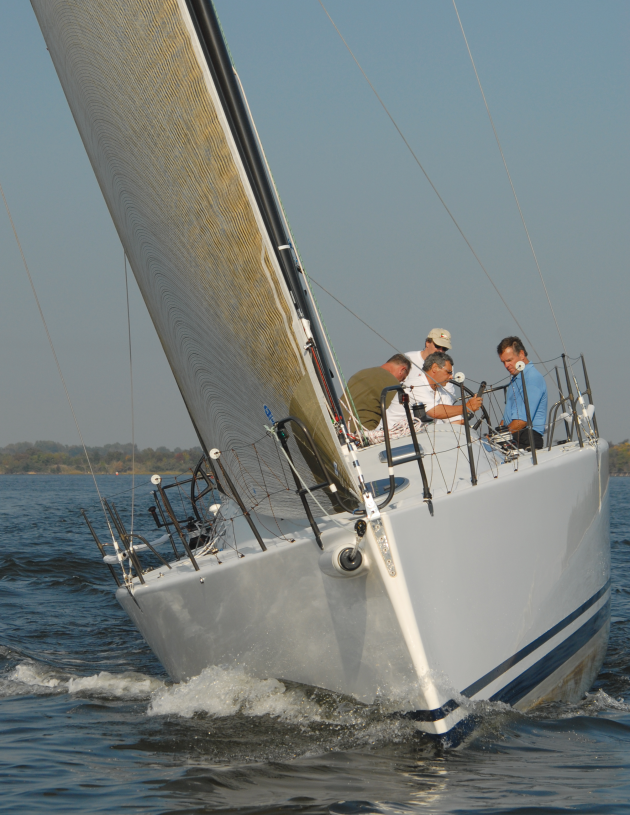
Carroll's newest project is the exciting King 40, a dual-purpose boat built in Argentina by King Marine for Carroll's new company, Summit Yachts. Don't let the phrase "dual purpose" mislead you. Yes, the King 40 has a surprisingly comfortable interior, and yes, it is built to the rugged standards of the IRC rule. But it has racing molded into its DNA. The King 40 is all about sailing fast, and that's not much of a surprise. What is a surprise is that after the race you won't want to check into a hotel, you'll be quite content down below. You may even want to hang out after the race for a week of relaxed cruising.
Carroll and his partner, George Carabetta, took Kevin Harrison and me for a Sailing Magazine test sail after the recent U.S. Sailboat Show in Annapolis, Maryland. It was late in the day and the autumn sun cast long shadows across the bay. Fortunately there was just enough of a sea breeze to enable us to see what the King 40 can do, and although this is a giveaway, there's no denying that we were impressed.
The details
Designed by Mike Mills, the King 40 is a handsome boat. It looks just a touch softer and a little more friendly than some of Carroll's early Farr-designed boats that were often a rakish blend of too many angles. The King 40 looks right. The sleek cabintrunk blends naturally into the foredeck and there is a single long portlight hinting at the boat's quieter cruising side. The ends are predictably long, although there's a nice lift to the stern and the profile view is pleasing. The narrow chord fin keel reaches down more than eight feet, a necessary evil in the pursuit of boat speed. The displacement is 15,655 pounds; the boat has some heft to it and it feels solid in the water.
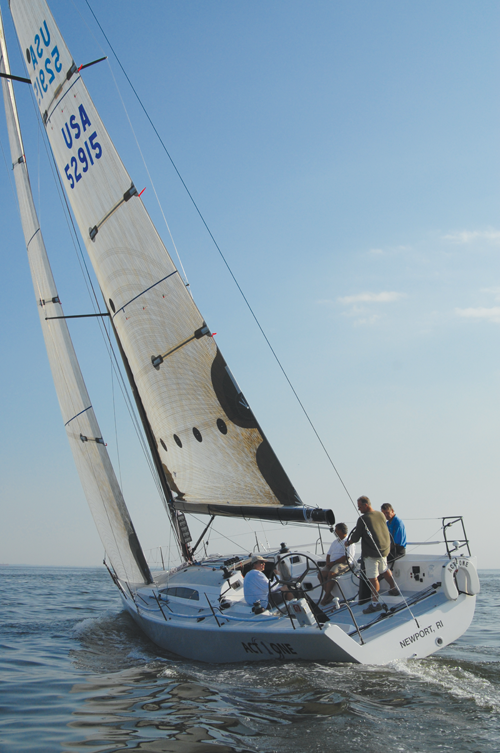
King Argentina in Buenos Aires was one of the leading builders of carbon fiber spars before turning to building custom yachts in 2003, when King Marine was formed. Since then the company has worked with some of the top designers around the world to produce a wide range of impressive boats, including both of Spain's 2007 America's Cup boats.
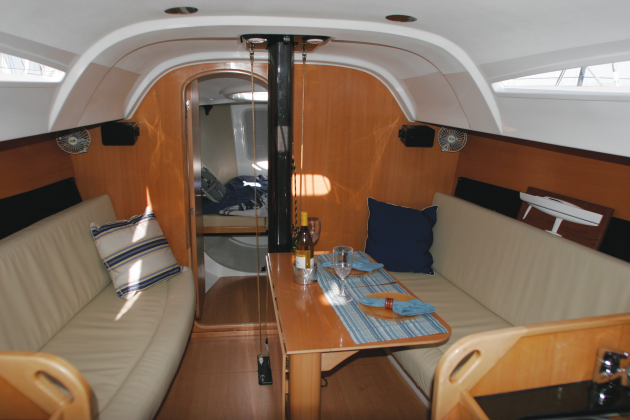
"We're not just comfortable with King Marine," said Carroll, "we're extremely pleased. They're pros, there was no learning curve, they're very high tech and they're super quality oriented."
The King 40 hull and deck are a vinylester vacuum consolidated composite sandwich construction. The foam core laminate is blended with biaxial and uni-directional E-glass fabrics. The hull and deck are bonded through a molded toerail in accordance with ORC regulations. The structural bulkheads are also bonded on all sides. The keel is iron and the balanced spade rudder has a carbon fiber stock-a feature that I am not wild about. An anodized aluminum frame forms the mast step. Scantlings are in full accordance with the EU's CE Category A requirements for offshore sailing.
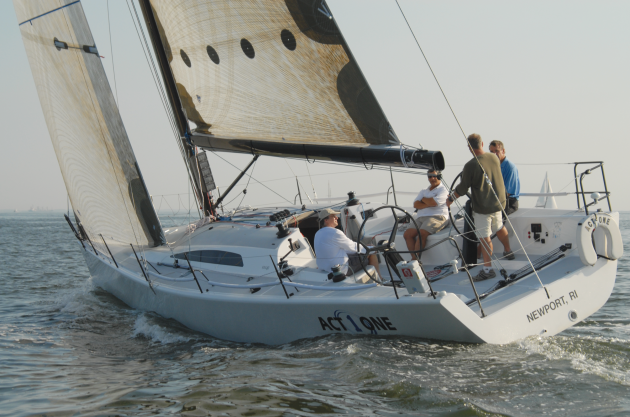
Mark Mills, in his designer comments, notes that the King 40 builds on two of his recent IRC designs, Mariner's Cove and Tiamat. Both boats were United Kingdom's IRC champions in 2006. What Mills particularly likes is the dual nature of these boats, and he's taken that to a new level with the King 40. He notes that the IRC requires a high level of stability, even in gale conditions, and in fact the King 40's stability index exceeds the requirements for most of the world's great ocean races. Stability in a gale translates into a smoother ride around the buoys and when cruising around the bay.

On deck
The cockpit is a study in function. Twin alloy wheels are mounted on custom composite pedestals offering excellent visibility on either tack. Sitting on the coaming you have fingertip control of the wheel. The open cockpit arrangement takes a bit of getting used to. I am not sure I would want to be hunkered down in this cockpit in a deep ocean blow, but then again I also have a feeling that I'd be having the ride of a lifetime too. I do know that the boat would be flying.
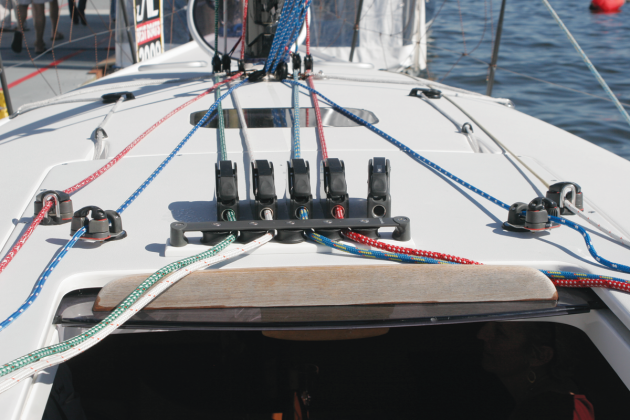
I was glued to the wheel as we accelerated smartly the moment we hoisted the main. Carroll, despite a bad knee, was bounding about the cockpit. The molded nonskid is superb and there are foot supports in logical places. Coming through the wind, he was on top of the backstay, punching the optional hydraulic adjuster just as the wind filled the main and it felt like we downshifted, rocketing forward as the main was trimmed up. The mainsheet and traveler leads are under deck, eliminating line clutter. The overall deck layout is impressive as the jib sheets are also led under deck.

Most deck hardware is Harken with a few Spinlock clutches thrown in for variety. The hatches and portlights are Lewmar. Not surprisingly a carbon fiber spar by King Composites is standard. There are two sets of swept-back spreaders eliminating the need for runners, which makes sail control that much simpler. The boom is aluminum and the spar is stayed with discontinuous rod rigging. The boat is available with either a standard custom carbon fiber spinnaker pole or a sprit. The flush-mounted mooring cleats are a nice touch. Soon we were whistling along on a close reach, touching 8 knots in about 10 knots apparent. Carroll apologized for not having a kite on board, "It was hectic after the show." The fractional sailplan is designed to fly a masthead spinnaker.
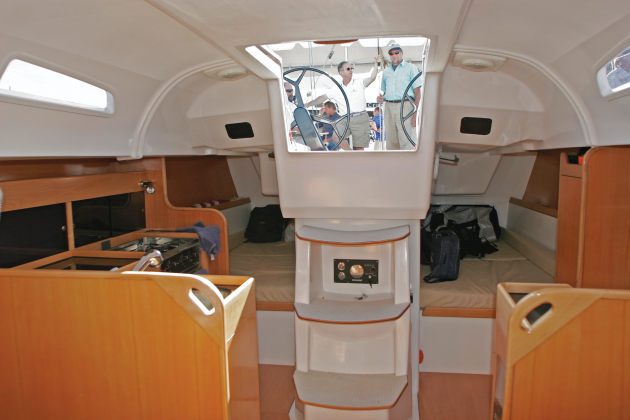
Down below
Kevin finally pried the wheel out my hands and I dropped below. The galley is immediately to starboard and like the rest of the boat it has a sense of purpose and a touch of grace foreign to most race boats. A single stainless sink is recessed into the composite, clear-coat carbon fiber counter top that sports decent fiddles. A two-burner stove is outboard as is a large top-opening icebox. Refrigeration is optional. There is plenty of useful storage space behind and above the stove and in three large drawers. I could definitely cook a nice meal at sea in this galley.
The are two aft cabins-a single to starboard and a double to port. These are more than just glorified sail lockers; there is room to stretch out and storage below the bunks and along the hull. The sit down, forward-facing nav station is opposite the galley and may be the most comfortable spot below. Most race boats still embrace the concept of a real navigation station, because of the importance performance and weather data play in winning races. Ironically, many cruising boats use the space for other things, accepting the sad fact that cockpit-mounted instruments have rendered the nav station below obsolete. Like the galley counter, the nav station is also clear-coated carbon fiber that looks really cool.
The saloon, finished in off white with bits of wood trim, includes facing settees with a composite and easily removed drop-leaf table between. Carroll noted that a choice of designer fabrics are available for the settees. Continuing forward, the enclosed head to starboard is an integral composite molding and includes a shower sump and overhead hatch. The forward stateroom features a good-sized V-berth, with large bureau and hanging locker to port. The space beneath the bunk is dubbed the sail locker, and there's also a clever duffle bag locker aft.
The systems throughout the boat reflect the genuine dual-purpose nature of the King 40. There are two water tanks with a total capacity of 55 gallons and hot and cold pressure water. Two group 31 batteries are standard. However, these should probably be upgraded if you plan to do more than race the boat. The custom electrical panel is first rate. The halogen reading lights are efficient and bright.
A 3JH4 X SD50 39-horsepower, three-cylinder Yanmar diesel is standard. A sail drive transmission and folding prop are also standard. Access is more than adequate. The 31-gallon fuel tank has an inspection plate and, with an efficient engine driving an efficient hull, should provide a season's worth of motoring. The only time you'll need to motor is when it is flat calm or when charging the batteries.
Under sail
Back on the bay, the wind had slackened as we found ourselves off the Eastern shore. Jibing over, we headed for home with the wind just aft of the beam. It would have been perfect with a cruising chute, but even without, we quickly overtook several other new boats out on respective boat tests. Carroll was respectful, and we fell off a few times to lessen the effect as we blew past them. Riding small wavelets it had no tendency to wander, the steering was precise. A small wheel adjustment resulted in a comparable course change. Nearing Back Creek, we were headed and brought the boat up a bit. The acceleration was impressive as we inched up over 8 knots.
The King 40 is an intriguing boat. It has the horsepower to sail around the buoys, it's built for ocean racing, and it has a comfortable interior that makes cruising a genuine option. I have no doubt that the sailboats of the future must have more than one purpose and that they must take advantage of the latest advances in techniques and materials to enhance their versatility. The King 40, having won Block Island Race Week, the New York Yacht Club's Annual Regatta and currently tearing up race courses in Europe, is already proving its on the right track.

Comments